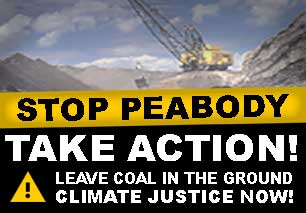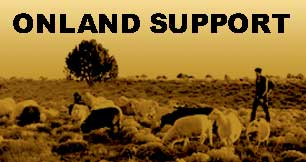UPDATE — Senate Bill 1003
April 6, 2006 by pathfinder
Filed under Archives
Navajo-Hopi Land Settlement Amendments of 2005
STATUS
The last major movement on the Bill was on December 12th of last year (2005). This
step was to place it on the Senate Calendar under “General Orders. Calendar No.
324.” What this means is that the Senate can pass the Bill and refer it to the
House of Representatives. In order for the bill to become law, the Senate and the
House will have to pass it sometime between now and the final adjournment (closing)
of the 109th Congress which is scheduled to close on or around October 6th of this
year. If the Congress does not pass it by October, then Senate Bill 1003 is dead.
There are two websites that provide ongoing information as to the status of the bill
(and all other bills) before Congress.
Government Trak is a nonprofit website that allows for tracking of bills and gives a
brief explanation of the stage that the bill is at. For those interested in
tracking Senate Bill 1003 this site is highly recommended.
http://www.govtrack.us/congress/bill.xpd?bill=s109-1003
This information is based on Congress’s own website that presents all of the major
written and scheduling information related to legislation.
http://thomas.loc.gov/cgi-bin/bdquery/z?d109:s1003:
CONGRESSIONAL VOTES & PROCEDURE
The Senate and House of Representatives have their own rules regarding how to vote
and pass legislation. There are 100 members of the Senate (2 from each state). The
rules of the Senate give an individual Senator tremendous power to influence, or
even hold up passage, of laws. Though rarely used, a “filibuster” allows an
individual or group of Senators to stop or delay the movement of bills based
entirely on procedure or rules that have nothing to do with the bill itself.
Sources inside Congress reported that two “holds” had been placed on Senate Bill
1003 in December which means that until these Senators give their approval or reach
a compromise on this bill it will probably not be passed. The sponsors and
supporters of the bill also will want the House of Representatives to pass it with
the exact same wording as the Senate. This means that there will also have to be
Senate-House negotiations.
The sponsor and supporters of Senate Bill 1003 will also want it to pass by
“Unanimous Consent” in the Senate and under “Suspension of the Rules” in the House.
These procedures are used to limit debate and consideration of legislation that the
Congress says are “uncontrevorsial.” Ironically, these procedures were used to pass
the 1996 Amendments to the relocation act which, when passed by the Senate in 1996,
took the House less than a week to sign into law.
CAMPAIGN
The campaign launched by and with residents of Black Mesa represent the one major
force opposing the bill on principle. One illustration of the fact that this bill
is a monstrous lie is that, since the original 1974 Relocation Act (P.L. 93-531),
less than 1/10th of 1 percent of the original population remains on “Hopi Partition
Land” (HPL). To say that Navajo (Dineh) have not complied with the law is a lie.
The main reason for removing the remaining resistors and completing the “ethnic
cleansing” is to facilitate coal mining. Congress could care less about a handful
of Navajo families living in the desert.
It is only people with conscience appealing to the conscience of key members of
Congress that is preventing yet another wave of human rights and environmental
destruction from going forward. Coal mining companies consider rocks, trees and
anything that is not coal to be either “interburden” or “overburden” which means
that it has to be removed. It is just a small step from considering rocks and trees
to be “waste” to considering humans living in the area to be waste which also has to
be removed. This is the logic behind the Relocation Acts although it is dressed up
as a land dispute.
U.S. NATIONAL ENERGY POLICY
Senate Bill 1003 is just the latest battle in an ongoing war arising out of our
industrial society and its voracious appetite for energy. For those who know the
background of the conflict, John Boyden is a monumental figure of greed and
corruption who played a key role in the passage of the 1974 Act. What is not as
well noted is that John Boyden had tremendous help from a consortium of energy and
utility companies called WEST Associates that provide electrical power to the major
cities of the Southwest. John Boyden died in the 1980s but WEST Associates, of
which Southern California Edision is a member, marches on.
The territory of both the Navajo Nation and Hopi Tribe were, in the 1970s, prime
candidates for inclusion as a “National Sacrifice Area.” The tremendous resources
of coal and uranium, and lack of concern, technology and money for remediation, led
many bureaucrats and scientists to advocate the designation of these lands as
“National Sacrifice Areas” to be killed on the altar of industrial and military
energy needs with both Navajo and Hopi removed to another area. Redirection of
energy consumption and conservation measures implemented as a result of the oil
shocks of the 1970s plus public opposition to the environmental and economic costs
of nuclear power led policymakers to drop these plans in the late 1970s and early
1980s.
Originally conceived under the “liberal” Carter presidency, these destructive and
inhuman energy plans have been picked up and resurrected under the Bush regime.
Unlike the 1980s, the petroleum crunch may now be permanent putting tremendous
pressure on indigenous communities to give up their remaining lands for coal,
natural gas and uranium. If history is any guide, the destruction of native lands
and people can only lead to global destruction from which no person, nation or
environment will escape.
REFERENCES
1. “Geopolitics of the Navajo-Hopi ‘Land Dispute’” by John Redhouse
https://supportblackmesa.org/Geopolitics.html
This is an excellent account of the land conflict putting it into its
historical-economic-political context and providing an excellent argument in support
of the Grandmothers of Black Mesa’s thesis that the desire for mineral resources are
the driving force behind the conflict.
2. “Requiem for Big Mountain: The Road to Relocation is Unrelenting,” Weinberg,
Bill. Native Americas. Ithaca: Sep 30, 1997.Vol. XIV, Iss. 3; pg. 30
This article give an excellent account of the genesis of the WEST group which has
proven far deadlier and longlived than John Boyden.
“The Begay family says their gravesites were bulldozed through by Peabody when the
Black Mesa mine opened. Peabody denies this. Glenna Begay’s son Carlos works tot
Peabody’s Kayenta mine and lives in the town of Kayenta, just north of Black Mesa.
“I’d rather live an Indian life here,” he says at his mother’s homesite. “But I
can’t build a new home because of the construction ban.”
These consequences were anticipated. In 1974, a National Academy of Science study
for the Nixon administration, “Rehabilitation Potential of Western Coal Lands,”
drawing on earlier proposals by the Ford Foundation, called for energy-rich areas
that cannot be effectively restored after exploitation to be declared “National
Sacrifice Areas.” This phrase was incorporated into the Nixon energy policy document
Project Independence, a response to the “oil shock” of the Arab embargo which called
for aggressively developing domestic energy resources. Much of Project Independence
was incorporated into the Carter energy program, which pledged to “cut through the
red tape, the delays and endless roadblocks to completing key energy projects.” In
1978, the Energy Department’s Los Alamos Labs in New Mexico issued studies
considering “rezoning uranium mining and milling districts to forbid human
habitation.” Exxon proposed Four Corners become a “National Energy Zone” outside
usual regulations. It was in this atmosphere that WEST was born.”


